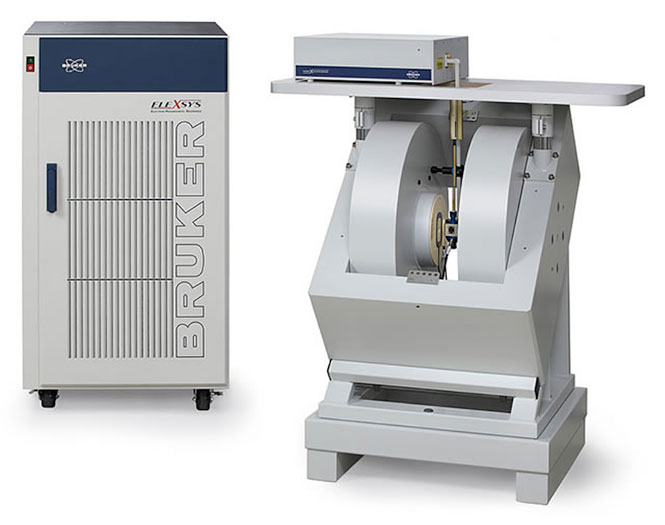Femtosecond laser spectroscopy
 The Ultrafast Chemical Physics lab houses two femtosecond lasers systems for ultrafast spectroscopy experiments. The orange lab has a Coherent Micra broadband ultrafast Ti:sapphire oscillator producing sub-15 fs laser pulses at 800 nm with a high (80 MHz) repetition rate. This laser is used with a custom-built pump-probe set-up that is used for femtosecond optical Kerr-effect experiments. Using an extra long optical delay line, we are able to achieve an accessible temporal range from 15 fs to 4 ns. The set-up can be used with a heating cell or a liquid nitrogen cooled cryostat while still achieving <20 fs time resolution in the sample.
The Ultrafast Chemical Physics lab houses two femtosecond lasers systems for ultrafast spectroscopy experiments. The orange lab has a Coherent Micra broadband ultrafast Ti:sapphire oscillator producing sub-15 fs laser pulses at 800 nm with a high (80 MHz) repetition rate. This laser is used with a custom-built pump-probe set-up that is used for femtosecond optical Kerr-effect experiments. Using an extra long optical delay line, we are able to achieve an accessible temporal range from 15 fs to 4 ns. The set-up can be used with a heating cell or a liquid nitrogen cooled cryostat while still achieving <20 fs time resolution in the sample.
The purple lab houses a state-of-the-art Coherent Legend Elite USP high-performance kHz-repetition-rate Ti:sapphire regenerative amplifier producing 23 fs pulses with >2.5 mJ per pulse at a repetition rate of 1 kHz. The system is equipped with an optical parametric amplifier (OPA) producing pulses tuneable from 1.2 um to 10 um. This laser system is currently used to carry out femtosecond optical Kerr-effect experiments with a maximum delay of 8 ns.
For more information and inquiries on collaborative work using this equipment, please contact Klaas Wynne.
Confocal fluorescence microscopy including fluorescence lifetime imaging
 The Ultrafast Chemical Physics lab houses (from May 2012) a Zeiss LSM 710 confocal fluorescence microscope system using an upright Axio Imager 2 microscope. The system uses a 405 nm diode laser for CW or pulsed excitation, a CW Argon multiline 458/488/514nm laser, a CW HeNe operating at 543nm and one at 633nm. The microscope is equipped with a Becker & Hickl fluorescence lifetime imaging (FLIM) set-up, which uses time-correlated single-photon counting (TCSPC) to achieve 120 ps time resolution. FLIM may be used to map different molecular environments.
The Ultrafast Chemical Physics lab houses (from May 2012) a Zeiss LSM 710 confocal fluorescence microscope system using an upright Axio Imager 2 microscope. The system uses a 405 nm diode laser for CW or pulsed excitation, a CW Argon multiline 458/488/514nm laser, a CW HeNe operating at 543nm and one at 633nm. The microscope is equipped with a Becker & Hickl fluorescence lifetime imaging (FLIM) set-up, which uses time-correlated single-photon counting (TCSPC) to achieve 120 ps time resolution. FLIM may be used to map different molecular environments.
For more information and inquiries on collaborative work using this equipment, please contact Klaas Wynne.
Confocal Raman microscopy
 The catalysis group manages a Horiba Jobin-Yvon LabRAM HR confocal Raman laser microscope system. It has an accessible range from 30 cm-1 to >4,000 cm-1 with a 0.35 cm-1 spectral resolution. Detection is carried out using an air cooled CCD while excitation at 532 and 325 nm is available. The microscope comes equipped with a Linkam heating stage that can heat samples up to 600° C.
The catalysis group manages a Horiba Jobin-Yvon LabRAM HR confocal Raman laser microscope system. It has an accessible range from 30 cm-1 to >4,000 cm-1 with a 0.35 cm-1 spectral resolution. Detection is carried out using an air cooled CCD while excitation at 532 and 325 nm is available. The microscope comes equipped with a Linkam heating stage that can heat samples up to 600° C.
For more information on this instrument and collaborative work, please contact Justin Hargreaves.
EPR Spectroscopy
The EPR laboratory houses a Bruker ELEXSYS E500 spectrometer for the study of magnetic materials (paramagnetic compounds and biomolecules, semiconductors, molecular magnets, magnetic impurities and defect materials). The spectrometer is equipped with the SuperX feature, comprising a selected high-power, ultra-low-noise Dual Gunn source for continuous-wave measurements at fixed frequency of 9.5 GHz in magnetic fields up to 1.4 T. Three resonators are available: a high-Q universal X-band cavity, optical transmission cavity with convenient access from the front and the rear side, and a dual-mode resonator specifically designed for anisotropic studies of triplets, biradicals, and of transition metal and rare earth ions. A combination of helium and nitrogen cryostats gives an accessible temperature range from 340 down to 3 K.
For more information on this instrument and collaborative work, please contact Stephen Sproules.

Other facilities
- Raman Optical Activity spectroscopy (contact Malcolm Kadodwala)
- James Watt Nanofabrication Centre
- Powder diffractometer
- Single crystal diffractometer
- SQUID
- Nanosecond flash photolysis (contact Goetz Bucher)
- Surface science systems (contact Malcolm Kadodwala)
- ESEM (environmental SEM can work at atomospheric press and bio sample)
- TGA
- Dynamic light scattering (contact Lee Cronin)
- Mass spectrometer (contact Lee Cronin)
- AFMs (contact Lee Cronin)
- High performance computing

